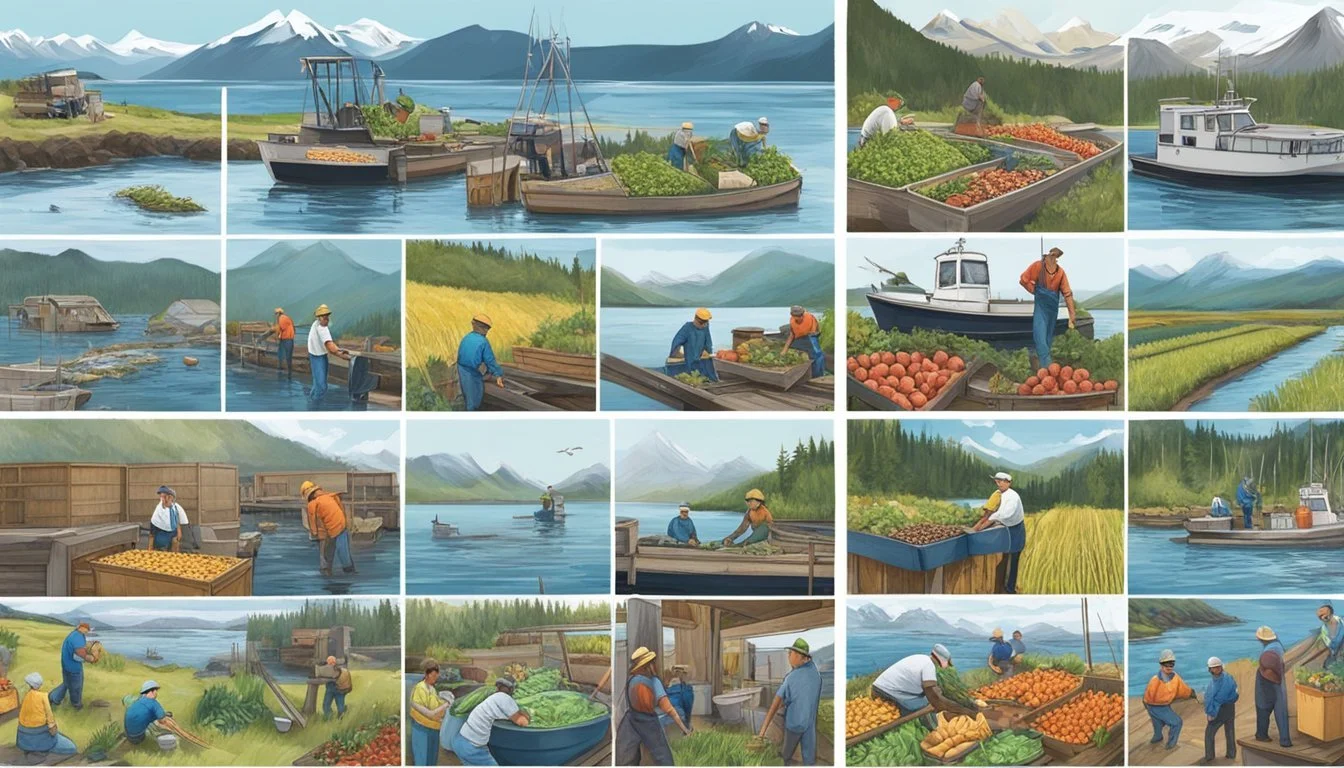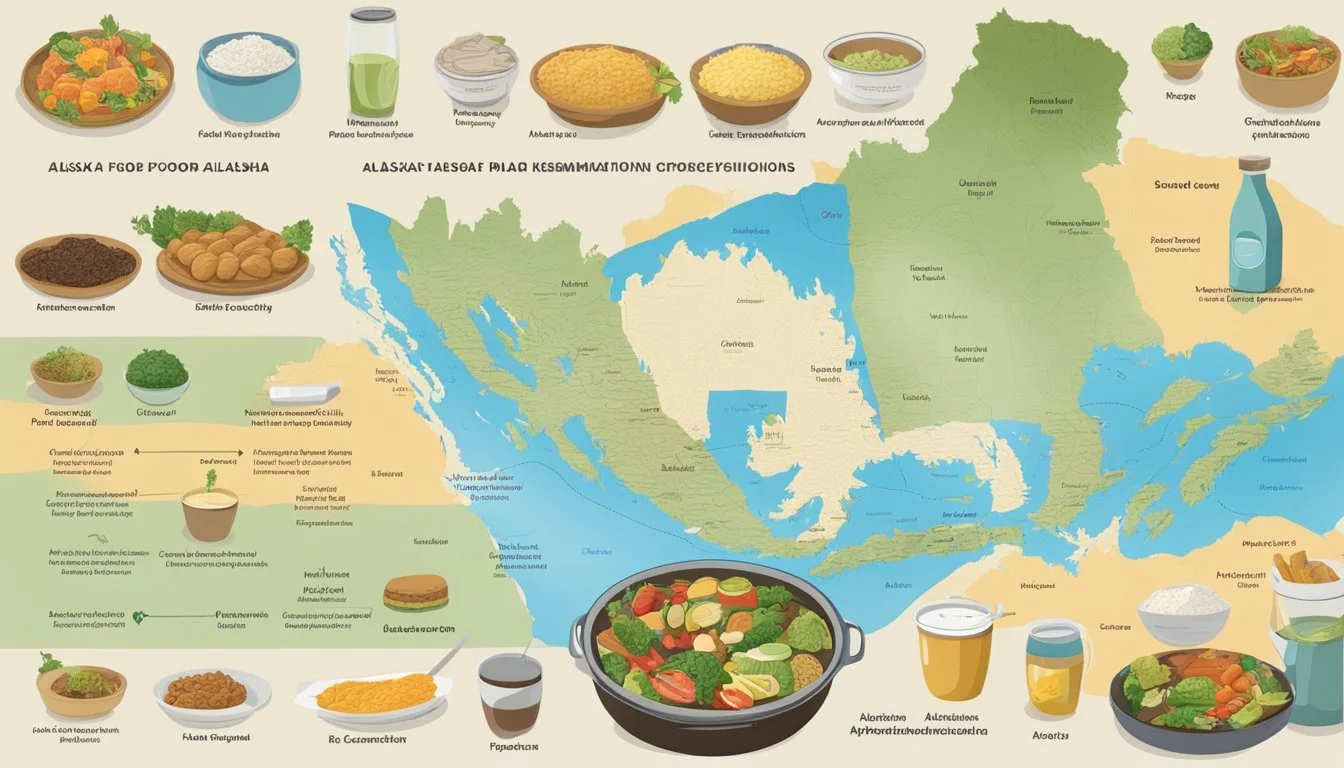Alaska Food Challenges
Tackling the Last Frontier's Culinary Giants
Alaska's vast landscapes and remote locations present a unique culinary landscape, one where food challenges and security concerns coexist. In the realm of competitive eating and entertainment, adventurous foodies encounter a variety of eating contests that spotlight the state's love for large portions and hearty meals. These challenges often come with the promise of free meals or cash prizes for those who can conquer daunting dishes, such as the enormous bowl of pho offered by PHONatik Vietnamese Cuisine in Anchorage, which challenges diners to finish 64 ounces of broth, 2 pounds of meat, and 2 pounds of noodles.
Beyond the enticing world of food competitions, Alaska faces the pressing issue of food security. The state's remote geography and harsh climate conditions pose significant hurdles for local food production, distribution, and storage. These challenges affect Alaskans' access to fresh and affordable food and underscore the importance of developing robust systems that support the state's food independence. Efforts to address food security are underway, with task forces and community groups seeking actionable steps to ensure all Alaskans have reliable access to nutritious food sources.
The Stakes of Food Security in Alaska
Food security represents a multifaceted and urgent challenge in Alaska. Geographic isolation and harsh climate conditions contribute significantly to the complexity of ensuring that all Alaskans have consistent access to nutritious and affordable food. The stakes associated with food insecurity in the largest state of the U.S. are high, impacting health, culture, and the economy on multiple levels.
Alaska Natives, integral to the cultural fabric of the state, are particularly at risk. Communities may depend heavily on traditional subsistence foods, which are under threat due to climate change and economic shifts. Disruption in these food resources can lead to health issues related to both nutrition and the cultural significance of traditional diets.
The following bullet points highlight the key challenges of food security in Alaska:
Health: Access to fresh produce and lean proteins is crucial for preventing diet-related diseases. A food-secure Alaska means better overall health outcomes.
Economy: A resilient local food system can reduce the reliance on costly imported goods and create jobs, invigorating local economies.
Culture: Preserving traditional foodways sustains Alaska Native heritage and knowledge.
Bridging the gap between urban and rural areas is essential for improving food distribution. Efforts by entities like the Alaska Food Strategy Task Force aim to identify and implement strategies that fortify the state’s food systems. They work towards a future where everyone in Alaska can obtain the food they need, when they need it, in a dignified and sustainable manner.
Understanding Alaska's Food System
Alaska's food system is uniquely influenced by its geographical location, climate, and the cultural importance of traditional foods.
Agricultural Infrastructure
Alaska's agricultural sector faces challenges due to the state's vastness and the limited arable land, which is concentrated primarily in areas like the Matanuska-Susitna Valley. Initiatives to strengthen the sector include increasing agricultural research to improve crop yields suited to the Alaskan climate and enhancing infrastructure to boost local food production. Strategies such as the creation of an Alaska Grown Marketing Institute aim to provide farmers with vital support to scale up production.
Traditional and Local Foods
Alaska places a strong emphasis on traditional foods as a cornerstone of cultural heritage and food security. The local food systems are underpinned by traditional hunting, fishing, and gathering practices, which remain essential for many communities. Efforts have been made to integrate traditional knowledge with modern distribution methods to ensure that local foods remain accessible across the state.
Supply and Distribution Challenges
The state's transportation infrastructure poses significant hurdles to consistent food supply and distribution, with many rural areas accessible only by plane or boat. Researchers at the University of Alaska focus on the various ways a food system supports health and address the challenge of food security beyond mere production. The task force’s work highlights the need for actionable steps to overcome these challenges.
Alaska's Unique Challenges and Opportunities
Alaska's vast landscape and extreme weather, coupled with social and economic considerations, present a myriad of challenges as well as opportunities for achieving food security.
Geographical and Climatic Impacts
Alaska's geographical expanse includes remote and rural areas where transportation of food is costly and challenging. Temperature extremes, with cold, long winters and short growing seasons, significantly impact food production. The soil in many parts of Alaska is also less suited for agriculture. However, these conditions provide unique opportunities for local food systems to adapt and innovate. Strategies such as the utilization of controlled environments and developing crops tailored to the northern climate are being explored. Climate change introduces both new hurdles and prospects, as shifting patterns could allow for extended growing seasons in some areas.
Economic and Social Factors
The economy of rural Alaskan communities often relies on a mix of subsistence activities, local food sources, and imported goods. Access to fresh water and the prevalence of disease can further complicate food security. Social factors play a significant role, as community cohesion and local knowledge can lead to collaborative approaches to food challenges. Education around sustainable practices and the bolstering of local economies through food-related initiatives offer pathways to resilience. The implementation of policies that address the economic and social well-being of these communities is as critical as the development of agricultural technology.
Local Efforts and Innovations
In addressing Alaska's food security challenges, local efforts and innovations are playing pivotal roles. These initiatives leverage university research, community partnerships, and governmental planning to develop sustainable solutions for the Alaskan food system.
University Research and Development
The University of Alaska Fairbanks is spearheading significant research and development to enhance the local food system. Studies are actively exploring climate-resilient crops and innovative food production methods suitable for Alaska's unique environment. This research serves as a critical foundation for developing more robust and localized food supply chains.
Community Initiatives and Partnerships
Community initiatives are instrumental in addressing food security, with numerous organizations forming partnerships to share resources and knowledge. Local groups, such as the Alaska Food Policy Council, work with various stakeholders to advocate for policies that support a sustainable and accessible local food system. These initiatives unite farmers, businesses, and consumers to fortify community resilience and food independence.
Governmental Support and Planning
Finally, the role of governmental entities, including the USDA, is vital in providing support and resources for planning and implementation. Governmental planning initiatives integrate with local efforts to expand distribution networks, improve food storage infrastructure, and establish programs that directly benefit rural and underserved communities, ensuring all Alaskans have access to nutritious food.
Improving Accessibility and Health Outcomes
Food security in Alaska faces unique challenges due to its vast distances and harsh climate, making accessibility and health outcomes critical matters. Optimizing these aspects will require tailored strategies that take both rural and urban needs into account.
Promoting Health and Physical Activity
Regular physical activity is essential for maintaining good health; it can also play a role in securing food security by fostering more resilient communities. In Alaska’s rural areas, initiatives aimed at integrating physical exercise with daily routines, such as community gardening or hunting skills workshops, support both health and local food production. For urban communities, public campaigns that highlight the benefits of active transportation to local markets can encourage healthier living and support urban agriculture initiatives.
Enhancing Food Access for Rural and Urban Communities
To improve food access in both rural and urban communities, Alaska is investing in infrastructure and partnerships.
In rural Alaska, strategies like the ones discussed in the ["USDA's recent report"] (https://www.usda.gov/media/blog/2023/09/20/critical-need-increase-food-security-rural-alaska) focus on developing supply chain solutions to reduce the cost and improve the efficiency of food delivery.
By contrast, urban centers benefit from different approaches such as the establishment of food hubs where local produce can be pooled and distributed effectively.
Both strategies aim to ensure that all Alaskans, regardless of their location, have access to nutritious foods that are fundamental to health and wellbeing.
Policy Recommendations and Future Directions
As Alaska confronts the challenges of ensuring food security, a spotlight has been cast on pivotal policy recommendations and future directives focusing on reinforcing food infrastructure and fostering economic growth with equity.
Strengthening Alaska’s Food Infrastructure
The Alaska Food Policy Council emphasizes the importance of solidifying the state's food infrastructure to strengthen Alaska’s food system. Specific actions include developing a comprehensive transport network to facilitate the efficient distribution of local food products. A significant initiative cited in the council's reports involves the establishment of food hubs geared towards bolstering regional food distribution capabilities, thus ensuring Alaskans' access to fresh, locally-grown produce year-round.
Fostering Economic Growth and Equity
Economic initiatives target the expansion of the local agricultural sector, underpinning both economic prosperity and equity. Recommendations call for dedicated support and incentives for new and existing agribusinesses, particularly those led by or serving indigenous communities. Investments in agricultural education are proposed to augment local expertise and spur innovation in farming techniques suitable for Alaska’s unique climate. As per the task force's insights, policies incentivizing retailers to carry Alaska-grown products have already shown success and are poised for expansion, coupling economic growth with wider food availability.
Conclusion
Building food security in Alaska requires actionable strategies due to its unique and pressing food security challenges. Several key recommendations have been outlined by local task forces, each designed to address the aspects that make Alaska's situation distinct. Among these, improving logistical frameworks for food distribution to remote areas is paramount, as well as enhancing local agricultural production capabilities.
Essential recommendations include:
Developing localized food systems to reduce dependency on imported goods.
Enhancing infrastructure, such as cold storage facilities, to support local producers and fishermen.
Educational initiatives aimed at increasing knowledge about traditional food sources, cultivation, and preservation methods appropriate for Alaska's climate.
Addressing food security in Alaska also involves acknowledging and respecting the cultural significance of food. It is not simply a matter of nutritional adequacy but also of maintaining the cultural heritage that is tied to local and indigenous food practices.
Efforts to tackle these challenges must be collaborative, involving state agencies, local communities, and indigenous leaders. Collective action fosters a resilient food system capable of sustaining Alaskans and their diverse needs.
An insightful framework for building food security in Alaska offers a pathway forward. However, continuous monitoring and adaptable management are critical to ensure that implemented strategies remain effective in the face of changing environmental and economic conditions.









